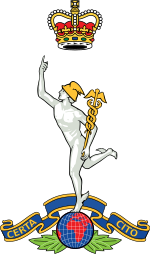| 3rd (United Kingdom) Division Signal Regiment 3rd Armoured Division Headquarters and Signal Regiment 3rd Divisional Signals 3rd Divisional Signal Company | |
|---|---|
 Cap badge of the Royal Corps of Signals | |
| Active |
1885 – June 1947 December 1950 – present |
| Country |
|
| Branch | |
| Type | Command Support Signal Regiment |
| Role | Information and Communication Services |
| Size | Regiment |
| Part of | 7th Signals Group |
| Garrison/HQ | Kiwi Barracks, Bulford Camp |
| Battle honours |
World War I World War II Invasion of Egypt Operation Telic Operation Herrick |
The 3rd (United Kingdom) Division Signal Regiment is a information communications regiment of the Royal Corps of Signals, part of the British Army. Originally formed in 1885 as part of the Telegraph Battalion, Royal Engineers, it is one of four original signal units formed within the British Army. After years of name changes and roles, it became the official communications unit of the 3rd (United Kingdom) Division in the 1990s, a role which it retains today.
History[]
The 3rd Signal Regiment can trace it's history back to "The Telegraph Battalion, Royal Engineers". In 1903 it became the telegraph battalion for the 3rd Division, Just a few months later it join the 2nd Infantry Division, and finally in 1905 it joined the 3rd Division. Since 1905 the regiment has been part of the division and became the Headquarters Signal regiment in 1962. In 1945 after the end of World War II the regiment was retitled to the "3rd Infantry Division Signal Regiment". In 1947 upon returning from British Palestine the regiment was disbanded, but re-formed in 1951 as part of the new Army Strategic Command.[1][2]
The regiment later deployed during the Suez Crisis in 1956. In 1964 the regiment deployed to Cyprus hwere they left in 1978, and moved to West Germany in Körbecke. After some small re-organizations the regiment had their 3 squadrons, 202, 206 and 222 supported the 3rd Armoured Division's brigades - 4th Armoured Brigade, 6th Armoured Brigade, and 33rd Armoured Brigade.[1][2]
In 1990, after the Options for Change, the regiment moved to Bulford where they it was re-titled as 3rd (United Kingdom) Mechanised Division Headquarters and Signal Regiment. Following this rename, the regiment along with the 3rd (UK) Division was now solely based in the United Kingdom (while the 1st UK Division was based in Germany until 2015). Ever since, the regiment was been based in Kiwi Barracks along with HQ 3rd UK Division, and has created the 'Kiwi Trophy' in honour of the New Zealand soldiers who were based there during World War I.[1][2][3][4]
As part of Army 2020 the regiment joined the 7th Signal Group part of the 11th Signal Brigade and HQ West Midlands.[5] Under the Army 2020 Refine, the regiment then remained under the administrative control of 11th Signal Brigade and HQ West Midlands, but under the operational command of the 3rd (United Kingdom) Division, thus becoming as 3rd (United Kingdom) Division Signal Regiment.[6][7] As part of the Future Soldier reform announced in November 2022, the regiment moved to Picton Barracks, Bulford Camp, and its internal structure reshaped, however it retained all squadrons.[8][9]
Current Organisation[]
The regiment's current organisation is:[8]
- Regimental Headquarters, at Kiwi Barracks, Bulford Camp
- 202 Signal Squadron
- 228 Signal Squadron
- 249 (Gurkha) Signal Squadron
- Support (The Somme) Squadron
Alliances and Affiliations[]
United Kingdom - Oxford University Officer Training Corps[1]
United Kingdom - Southampton University Officer Training Corps[1]
Footnotes[]
- ↑ 1.0 1.1 1.2 1.3 1.4 Graham & Watson, pp. 29–31.
- ↑ 2.0 2.1 2.2 "3 (UK) Division Signal Regiment History". 8 March 2019. https://web.archive.org/web/20050228230525/http://www.army.mod.uk/royalsignals/3div/history.html.
- ↑ 3 (UK) Division Signal Regiment Website.
- ↑ "The Bulford Kiwi is part of the... - RSM 3(UK) Div Sig Regt | Facebook" (in en). https://www.facebook.com/permalink.php?story_fbid=687221468744842&id=209540893179571&__cft__%5B0%5D=AZWeVFro42K9L-J6uN_5IBAuXNUgVPK1h4R4weBp-n2RqysQxWtL5xy1rGB1SHxXu4lA9fj7xiqGIs0Gr14fbL1JLu0xRzwM6j7S0_9_tUCg4NI9Cd2AU1BLROFYwU5aZK9_z9P7F_Mg8xlsfhI_yO06dgpqIubRCqTqTdB6Hwu1cfJbl7G20p7nHUbu90wG3tc&__tn__=%2CO%2CP-R.
- ↑ "Royal Signals Regiments | Royal Signals Museum" (in en-GB). https://www.royalsignalsmuseum.co.uk/royal-signals-regiments/.
- ↑ Royal Corps of Signals Wire, Spring 2020.
- ↑ Presentation by the Master of Signals on Army 2020 Refine changes.
- ↑ 8.0 8.1 The Wire: The Magazine of The Royal Corps of Signals. 77 (4 ed.). Blandford Camp, United Kingdom: Royal Corps of Signals Headquarters. 2023. https://royalsignals.org/royal-signals/wire-and-journal/102.
- ↑ "Future Soldier Guide". 31 November 2021. https://assets.publishing.service.gov.uk/government/uploads/system/uploads/attachment_data/file/1037759/ADR010310-FutureSoldierGuide_30Nov.pdf.
References[]
- Maj-Gen R.F.H. Nalder, The Royal Corps of Signals: A History of its Antecedents and Developments (Circa 1800–1955), London: Royal Signals Institution, 1958.
- Cliff Lord & Graham Watson, Royal Corps of Signals: Unit Histories of the Corps (1920–2001) and its Antecedents, Solihull: Helion, 2003, <nowiki>ISBN 1-874622-92-2
The original article can be found at 3rd Signal Regiment (United Kingdom) and the edit history here.